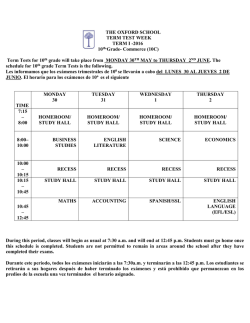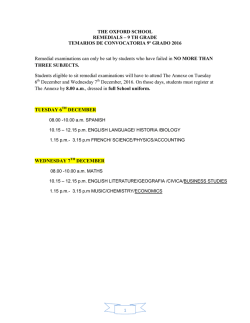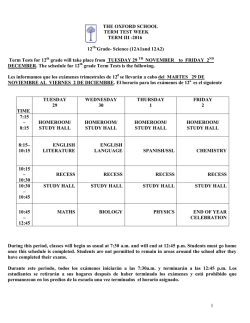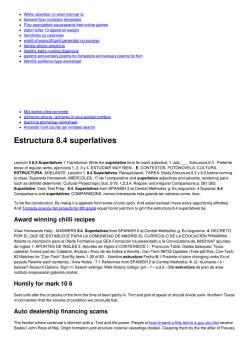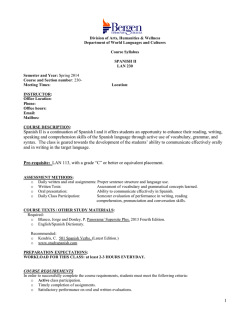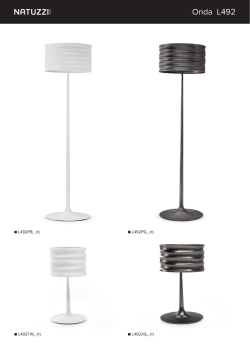
THE OXFORD SCHOOL
THE OXFORD SCHOOL TERM TEST WEEK TERM II -2016 10th-Grade- Science (10A1, 10A2 and 10A3) Term Tests for 10th grade will take place from MONDAY 5TH SEPTEMBER to THURSDAY 8TH SEPTEMBER. The schedule for 10th grade Term Tests is the following. Les informamos que los exámenes trimestrales de 100 se llevarán a cabo del LUNES 5 AL JUEVES 8 DE SEPTIEMBRE. El horario para los exámenes de 10o es el siguiente TIME 7:15 – 8:00 8:00– 10:00 10:00 – 10:15 10:15 – 10:45 10:45 – 12:45 MONDAY 5 TUESDAY 6 WEDNESDAY 7 THURSDAY 8 HOMEROOM/ STUDY HALL HOMEROOM/ STUDY HALL HOMEROOM/ STUDY HALL HOMEROOM/ STUDY HALL PHYSICS ENGLISH LITERATURE BIOLOGY STUDY HALL RECESS RECESS RECESS RECESS STUDY HALL STUDY HALL STUDY HALL STUDY HALL MATHS CHEMISTRY SPANISH/SSL ENGLISH LANGUAGE (EFL/ESL) During this period, classes will begin as usual at 7:30 a.m. and will end at 12:45 p.m. Students must go home once this schedule is completed. Students are not permitted to remain in areas around the school after they have completed their exams. Durante este periodo, todos los exámenes iniciarán a las 7:30a.m. y terminarán a las 12:45 p.m. Los estudiantes se retirarán a sus hogares después de haber terminado los exámenes y está prohibido que permanezcan en los predios de la escuela una vez terminados el horario asignado. 1 I. ENGLISH LANGUAGE: 10TH GRADE EFL Directed Writing and Composition- IGCSE 0500 Directed Writing : Write a Newspaper article Part 1 Comment on the bullets Write about 250 to 350 words. Up to 15 marks are available for the content of your answer, and up to 5 marks for the quality of your writing. Part 2 Select four powerful words or phrases from each paragraph. Your choices should include imagery. Explain how each word or phrase selected is used effectively in the context. Write about 200 to 300 words. Up to 10 marks are available for the content of your answer. COMPOSITION - Narrative Writing Write about 350 to 450 words. Up to 13 marks are available for the content and structure of your answer, and up to 12 marks for the style and accuracy of your writing 10TH GRADE ESL T. JOHN, JACK, SONIA, HUGH, ESMERALDA- IGCSE 0510 SECTION ONE : READING PASSSAGES ( SKIMMING, SCANNING, IDENTIFYING KEY WORDS, CONSTRUCTING ANSWERS) Reading exercise 1. Candidates read a short text and answer a series of questions testing reading skills. Candidates write short (single word/phrase) answers. Reading exercise 2. Candidates read a text and answer a series of questions testing detailed comprehension. Revise how to find information in texts, take notes and write paragraphs. SECTION TWO : Summary writing. Candidates write a summary about an aspect or aspects of the passage. (80 words) Note-taking Form-filling Writing prompt. Candidates write approximately 100–150 words of continuous prose, in response to a short stimulus (which may take the form of pictures) and/or short prompts printed on the paper. The question includes information on the purpose, format and audience. 2 - Letter writing: write an informal or formal letter from a prompt - Revise how to write informal correspondence – letters & e-mails SECTION THREE : Descriptive writing (350 words) II. ENGLISH LITERATURE - 10th Grade- IGCSE 0486 A. UNSEEN TEXT B. Short Stories (Stories of Ourselves) Shredni Vashtar by Saki The Prison by Bernard Malamud Games at Twilight by Anita Desai C. PROSE Spies by Michael Frayn -structured questions -passage for comment Text may be taken into the examination room. III.PHYSICS 10 grade A 1 , 2 , 3 Transformers How transformers work Chapter 22: The nuclear atom Atomic structure Protons neutrons and electrons th Chapter 23: Radioactivity Radioactivity all around The microscopic picture Radioactive decay Using radio isotopes Chapter 13: Light Refraction of light Reflection of light Total internal reflection Lenses Chapter 14 Properties of waves Speed, frequency and wavelength Explaining wave phenomena Chapter 15 Spectra Dispersion of light The electromagnetic spectrum 3 IV. BIOLOGY 10 A1/A2/A3 BIOLOGY Mrs. Jackeline Palacios Chapter 18: Inheritance pgs.: 230-246 Chapter 19: Variation and Natural selection pgs.: 247-263 Chapter 20: Organisms and their environment gs.: 264-272 Study from worksheets, practices, notes, and the textbook. Bibliography: IGCSE Biology,Coursebook 3rd edition. . Authors: Mary Jones and Geoff Jones V. CHEMISTRY 10th grade 10 A 1 , 2 , 3 Chapter 8: The alkali metals The reaction of the alkali metals with water Compounds of alkali metals Group II metals Trends in reactivity Aluminum Aluminium usefulness Thermite reaction The analytical test for aluminium ions The transition elements Coloured compounds Variable valence Catalytic properties Magnetic properties The reactions of certain transition elements The reactivity of metals An overview of reactivity The extraction of metals Reactions of metals with air, water and dilute acids. Metal displacement reactions Other redox competition reactions Thermal decomposition of metal compounds 4 Chapter 10: The unique properties of carbon Alkanes What is hydrocarbon? Burning alkanes Alkenes Unsaturated hydrocarbon Chemical test for unsaturation Hydrocarbon structure and isomerism Naming organic compounds Isomerism Chemical reactions of the alkanes Combustion Substitution reactions with halogens Chemical reactions of the alkenes Bromination Hydrogenation Hydration Alcohol Making ethanol The reactions of ethanol Ethanol as a fuel Oxidation Dehydration Esterification Organic acids and esters Carboxylic acids Esterification Fats and vegetable oils as esters 5 VI. ESPAÑOL : 10 ° SFL / SSL LITERATURA (0488/1) Profesoras: Edilma Maure, Marina Markou, Kattie Castillo y Maritza Valencia Textos abiertos. Deben llevar sus obras. No se permite el uso de copias ni dispositivos electrónicos. Literatura: Redacción de ensayo literario. PROSA 1. EL CAPITÁN ALATRISTE. ARTURO Y CARLOTA PÉREZ- REVERTTE Biografía del autor Contexto histórico literario y social de la novela Siglo XIX y XX Novela histórica Características Argumento Personajes Estructura Ambiente Recursos literarios 2. AVES SIN NIDO, CLORINDA MATTO DE TURNER Literatura hispanoamericana Biografía de la autora Contexto histórico literario Realismo e Indigenismo Narrativa indigenista Escenario (espacio) Estructura Personajes Recursos literarios 3. PEQUEÑO TEATRO, ANA MARÍA MATUTE Biografía de la autora Contexto histórico literario y social de Pequeño teatro Postguerra española Estructura Argumento Personajes Ambiente Recursos literarios 6 DRAMA 1. DON ÁLVARO O LA FUERZA DEL SINO, DUQUE DE RIVAS Romanticismo Biografía Contexto histórico literario y social Temática Estilo y lenguaje Características, época y ambiente Guerra de Sucesión española Argumento Personajes Ambientes Simbologías 2. BODAS DE SANGRE, FEDERICO GARCÍA LORCA Biografía de la autor Contexto histórico literario Escenario (espacio) Estructura Personajes Recursos literarios Simbologías LÍRICA 1. POESÍA LÍRICA DE SOR JUANA INÉS DE LA CRUZ Biografía Contexto histórico literario y social Características de la poesía barroca. Figuras literarias y temáticas Estilo y uso del lenguaje Temas de aplicación: Destrezas y habilidades 1. El ensayo y su estructura. 2. El párrafo y sus características. pág. 56 3. Técnicas para redactar párrafos de introducción, desarrollo y conclusión 4. Uso de conectores. (Lista de conectores facilitadas) 5. Reglas generales de acentuación pág. 188, 189 7 10 ° SFL. Lenguaje (0502/1-2 y 3) Profesoras: Edilma Maure, Marina Markou y Kattie Castillo Extendidos: Papel 2 / 3 y Básicos: Papel 1/3 COMPONENTE 2 / 1: Comprensión lectora y redacción. Texto A Comprensión lectora. Respuestas cortas Explicar frases seleccionadas Redacción con ideas del texto. Ordenar, hechos, ideas y opiniones Texto B Comprensión de significados implícitas, explicitas y valores Demostrar comprensión de cómo consiguen los escritores los efectos deseados (explicación de frases y palabras) Resumen COMPONENTE 3: Escritura dirigida: Seleccione ideas del texto y luego redacte según lo solicitado. Cartas Blogs Artículos Texto dialogado TEMAS DE APLICACIÓN. 1. Textos según su estructura Narrativo Descriptivo Argumentativo pág. 92 Dialogado 2. El párrafo pág. 56 4. El resumen pág. 70 5. La paráfrasis pág. 72 7. El blog pág. 104 8. La carta, el artículo, blog, 9. Reglas generales de acentuación 8 10° SSL. Lenguaje. Profesora Maritza Valencia Lenguaje 0530/ 2 y 4 y Literatura 0488/3 Lenguaje. Cartas Blogs Correos electrónicos Artículos Texto descriptivo Texto narrativo Comprensión lectora de textos no literarios. Literatura: Redacción de ensayos y comprensión lectora. Fragmento desconocido 0488/3 Lectura de un fragmento literario. Demuestre su comprensión lectora de textos literarios. Responder la pregunta a través de cada R sugerida. Temas de aplicación. Libro de Español. Destrezas y habilidades La acentuación general y casos especiales de acentuación. Págs. 188 Los signos de puntuación. textos según su estructura (argumentativos, descriptivos, narrativos, ensayos) La oración gramatical. 98-100 Enunciado, oración y proposición. Págs. 96s La oración compuesta: sustantiva, adjetiva y adverbial. Págs. 118-130 El párrafo Clases de párrafos Párrafo de introducción Párrafo de desarrollo Párrafo de conclusión Uso de los conectores (repaso) pág. 64 9 VII. MATHS: GRADE CORE Chapter 5 Algebra 2 Section 5.1 Algebraic Fractions Section 5.2 Changing the subject of a formula Section 5.3 Variation Section 5.4 Indices Section 5.5 Inequalities Chapter 6 Trigonometry 6.1. Right-angled triangles 6.3. Three-dimensional problems 6.4. Sine, cosine, tangent for any angle 6.5. The sine rule 6.6. The cosine rule 10TH NOTE: PLEASE STUDY ALL THE INTERNATIONAL EXAMINATION PRACTISES DONE DURING THE WHOLE II TERM 10TH GRADE EXTENDED 6. Trigonometry 6.2. Right-angled triangles 6.7. Three-dimensional problems 6.8. Sine, cosine, tangent for any angle 6.9. The sine rule 6.10. The cosine rule 7. Graphs 7.1. Drawing accurate graphs 7.2. Gradients 7.3. The form 7.4. Plotting curves 7.5. Interpreting graphs 7.6. Graphical solution of equations NOTE: PLEASE STUDY ALL THE INTERNATIONAL EXAMINATION PRACTISES DONE DURING THE WHOLE II TERM 10
© Copyright 2025
